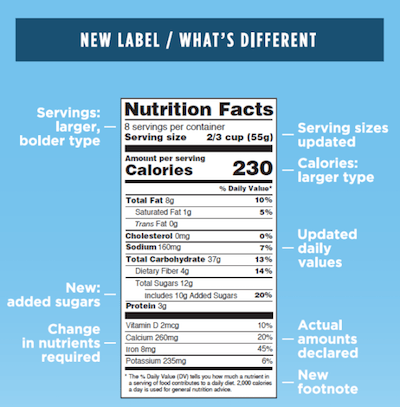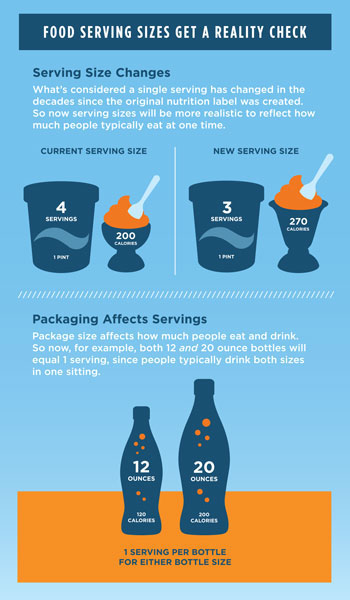On May 20, 2016 the Food and Drug Administration (FDA) finalized a new Nutrition Facts label for packaged foods that are sold in the United States. For more than 20 years, the Nutrition Facts label has remained untouched, despite changes in the American diet. Since there is a label on almost every food and beverage item sitting on the grocery store shelves, a change needed to be made. This new label will reflect the most current scientific findings including the link between diet and chronic diseases such as diabetes, heart disease and obesity.
As we all know obesity continues to be a major problem in this country and carrying extra weight can lead to serious medical problems. With this new Nutrition Facts label, which will be going in effect on July 26, 2018, I feel it can help children and adults learn how to make smarter and more informed food and beverage choices.
Even though we will not see any changes for a couple of years, here is a sneak peek of what is to come…
1. Added sugars will now be included!
This change is probably what most people are excited about. Added sugars will now be included on the Nutrition Facts label, which will be both listed in grams and in percent daily value. The percent daily value (%DV) tells us how much of that specific nutrient we will be getting in one serving of food, which is based on a 2,000 calorie diet.
The FDA defines added sugars as any type of sugar (including honey, syrups, and concentrated fruit/vegetable juices) that is added during processing. This new category is meant to help individuals cut down on added sugar in their diet and also aiding in label comparison. This addition can help people differentiate between added sugar and naturally occurring sugars, which are found in fruits, vegetables, and dairy. Even though added sugars get a bad rap, they can still be part of a healthy diet plan, as long as they are consumed sensibly.
This addition on a food label can make it easier to educate children about reducing added sugar in their diet. It will now be easier to distinguish between natural sugar and added sugar, especially in items such as chocolate milk and juices.
2. Changing serving size
Since the amount of food and drink consumed has changed over the years, the serving size needed to be revamped. By law, serving sizes must be based on amounts of food and beverages people are actually consuming, not what they should be eating or drinking. With the new Nutrition Facts label, serving sizes will be more realistic to reflect how much a person would normally eat in one sitting. For example, the serving size of soda will increase from 8-ounces to 12-ounces and yogurt will decrease from 8-ounces to 6-ounces.
One major concern is by increasing the serving size on products, it possibly could cause overeating, which in the long run could lead to health problems such as obesity, diabetes, and heart disease. The key is making healthy choices and monitoring portion size, especially with children. Understand that the serving size of a food or beverage is just a guide; we do not have to eat or drink that exact amount.
One major concern is by increasing the serving size on products, it possibly could cause overeating, which in the long run could lead to health problems such as obesity, diabetes, and heart disease.
3. Bye bye to calories from fat!
The “Calories from Fat” line has been eliminated due to recent research indicating that the type of fat is more important that the amount. Healthy fats such as olive oil, nuts, seeds and avocados contain mostly, if not all their calories from fat. No need to worry about missing this on a label, just choose healthy fats and you will be just fine!
4. Vitamins & Minerals Swap!
Vitamin D and potassium are now a requirement on the food label since deficiencies of these vitamins are a public concern. Potassium is vital for heart health and vitamin D works together with calcium for bone health. Calcium and iron will continue to be on the food label but vitamin C and vitamin A will no longer be required, but can be added on a voluntary basis. Vitamins and minerals will be declared in actual amounts and also percent daily value (%DV).
5. Multi-Serving products gets a new column
For food items that can be consumed in one or multiple servings, there will be a second column. The first column will indicate the amount of calories and nutrients “per serving” and the second column will show how many calories and nutrients “per container”. Remember to look at the column that applies to how much you ate or drank.
6. Calories become larger (I mean the font size!)
Calories are now highlighted and larger in size. This change helps individuals see the word “calories” at a quick glance. Plus bolded and increased size screams “look at me, I am important”.

7. Sodium & Dietary fiber recommendations change
The percent daily values (%DV) have been changed to reflect the new 2015 Dietary Guidelines for Americans. These guidelines (for most adults) have changed from 25g to 28g for dietary fiber and 2,400mg to 2,300mg for sodium. These changes might sound minimal, but they are important for overall health.
8. Trans-fat continues…
Over the next year or so, the amount of Trans-fat will be decreased but still not fully eliminated from foods. Due to this, FDA will continue to require it on the food label. Partially hydrogenated oils, a source of artificial trans-fats have been shown to be harmful to our health. Over time partially hydrogenated oils will be phased out, but we still have to keep an eye out for them.
9. In-between serving sizes become single servings
Packages that contain between one and two servings will now be labeled as one serving. For example, a 15- ounce soda or can of soup will now be labeled as one serving. Realistically, most people would consume a full can of soup in one sitting.
It will be a few years before we see any changes to our labels, but now we know what to expect. This new Nutrition Facts label can help provide individuals with the knowledge to make positive changes in their diets.
To learn more, visit the Food & Drug Administration's website here.









